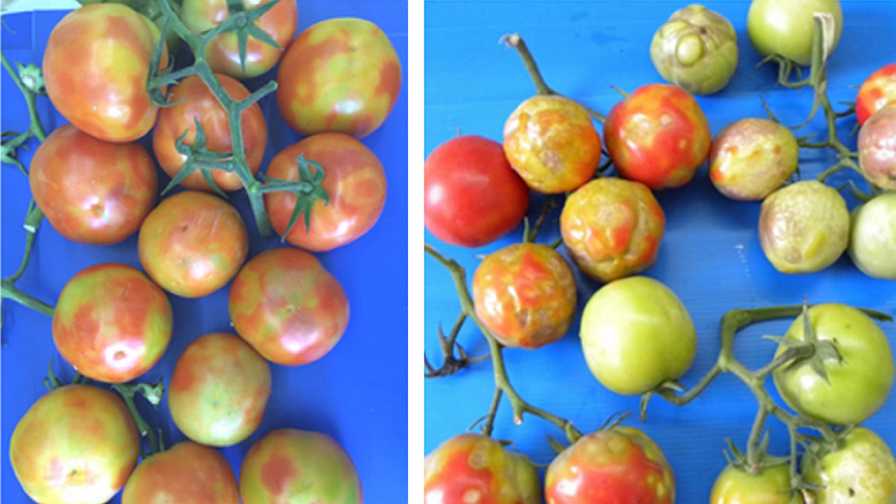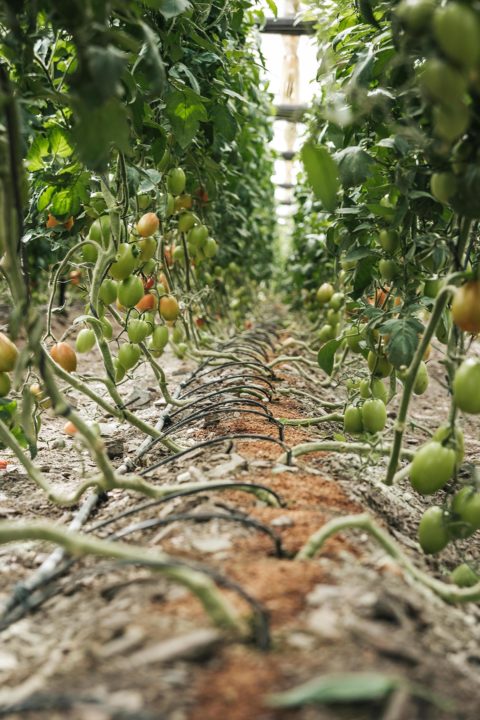How Canadian Tomato Breeders Are Tackling a New Virus Head-On

Some of the symptoms of the tomato brown rugose fruit virus.
Photos courtesy of Luria et al., 2017
Since 2013, the greenhouse tomatoes-on-the-vine (TOVs) breeding program at the Vineland Research and Innovation Centre in Canada has focused on developing high-yielding varieties with improved flavor and production traits adapted to Canada’s climate.
The program reaped success in 2019 with the commercial release of three TOV varieties with new and differentiated flavor profiles preferred by consumers.
That same year, thanks to funding from the Ontario Ministry of Agriculture, Food and Rural Affairs (OMAFRA) and Ontario Greenhouse Vegetable Growers (OGVG), the focus of the breeding project is now encompassing resistance to diseases, including the devastating tomato brown rugose fruit virus (ToBRFV), for which no resistant cultivars currently exist.
“Our rugose project plans to identify a source of resistance to the virus and then develop a genetic marker that will allow us to quickly breed rugose resistance into our tomato lines,” says Travis Banks, Vineland’s Director, Plant Variety Development.
The Vineland team is involved in two separate efforts to identify rugose resistance. The first is a collaboration with Agriculture and Agri-Food Canada (AAFC) to screen hundreds of diverse tomato lines from Vineland’s germplasm collection. Also underway is a collaboration with a group of international breeding organizations to screen a large set of germplasm in Europe and Asia. This collaboration has been fruitful and promising sources of resistance have been identified. These have been integrated into Vineland’s breeding program to add resistance to our Canadian-adapted TOVs.
“Industry and government have been clear that addressing this new disease is a top priority. Vineland is working as quickly as possible, and Ontario-adapted TOVs from our breeding program with rugose resistance are on the horizon,” Banks says.
Greenhouse Grower recently caught up with Banks to learn even more.
Greenhouse Grower (GG): What sort of a timeline are you looking at for when these varieties might be made available?
Banks: We think it’s going to be about two years before we have seed available for growers to evaluate, and then another year to have commercial level quantities of seed. The expectation is even when we have these initial varieties ready to go, the growers are still going to want to trial them in their greenhouse.
GG: How are you working with these growers on trials?
Banks: One of the benefits of our breeding program is that we’ve found a few key collaborators in the Leamington area who are willing to take an early look at our material and help our selection process. Every grower has their own way of doing things, and we want to make sure that our commercial releases are going to hold up with the full spectrum of growers. Their participation is going to be important.
GG: When it comes to the balance between developing varieties that work well for both growers and consumers, how are you working to blend those concerns together?
Banks: We were fortunate when we started this breeding program, flavor and yield were the two characteristics we looked at first. Our biochemist, Dr. David Liscombe, is a real expert in understanding tomato flavor, and as we go through our selection process, he’s looking at material and noting how it performs in terms of yield, fruit set and size, and cluster characteristics. At the same time, these tomatoes also go through Dr. Amy Bowen, who runs our consumer insight group. Those tomatoes are put in front of a human sensory panel, and all that information gets back to our breeder. As we continue to improve these varieties by adding ToBRFV resistance, we’ll maintain that same way of doing things, making sure that the preferred consumer flavor the tomatoes have is maintained, and we’ll do that both through chemical evaluation and through human sensory evaluation.
GG: Can you talk about the current severity of ToBRFV in Canada, and the industry response?
Banks: It’s definitely a concern, and growers are being very cautious to keep infections out of their greenhouse. It’s a virus that spreads easily, and if it enters a greenhouse, it can make the crop unmarketable for producers. The provincial and federal governments have been working with growers to establish guidelines to enhance biosecurity and cleaning protocols. It was great to see how quickly our funding agencies responded to the threat by being proactive and making funding available.









